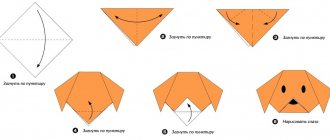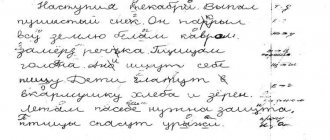Article:
Agrammatic dysgraphia is characterized by specific errors in writing in the form of disorders of morphological and syntactic generalizations. Typical errors:
- Replacement of suffixes, prefixes, prefixes. “Overwhelms” - “overwhelms”, “kittens” - “kittens”, “coup” - “turn”.
- Incorrect use of prepositions. “Over your head” - “on your head”, “before the exam” - “ahead of the exam.”
- Changing case endings of nouns. “Several trees” - “several trees”, “told dad” - “told dad”.
- Broken sequence of words in a sentence. “Masha said she wanted a doll” - “Masha said she wanted a doll.”
- Incorrect use of pronoun cases. “Near them” - “near him”, “call me” - “call me”.
- Incorrect use of number of nouns. “The dogs are running” - “the dogs are running”, “a lot of apples” - “a lot of apples”.
The prerequisites for agrammatic dysgraphia are oral speech disorders and general speech underdevelopment.
The written work of dysgraphic children looks like this:
Agrammatic dysgraphia has common features with dysorthography, which are expressed in the following features:
Game-Exercise No. 1. Work on memorizing words and terms (their graphic version)
Make up vocabulary words (or terms, for adult listeners) from syllables, circle them in different colors.
Speech material for first-graders: alphabet, crow, law, came in, they are calling, textbook, teacher, glue, carpet.
Speech material for cadets and listeners on terminology (example): analysis, synthesis, verification, safety, accident, gaff, car pump, liquidation, arson.
! If possible, use word breakdowns or insert pictures and other visual cues to enhance comprehension.
Correction and correction of dysgraphia at a speech therapy center in Moscow
Dysgraphia cannot be corrected using a school curriculum ; special classes with a speech therapist, physical therapy, and home exercises will be needed. Corrective work on dysgraphia is built individually with each student, since problems with writing can be different, as well as the child’s reaction to corrective classes.
To correct dysgraphia, a speech therapist develops a system for filling gaps that are important for developing writing skills. Additionally, work is being done to develop speech, expand vocabulary, improve attention and memory.
Physical therapy and games with magnet letters are allowed, especially for preschoolers and primary schoolchildren.
Our specialists will help eliminate errors in a child’s writing, expand vocabulary, develop speech hearing, train auditory attention and auditory-speech memory.
Game-Exercise No. 2. We work on word order to help the child/adult understand the text.
Option for children.
Adding one word at a time, make sentences based on the picture. Be sure to ensure that your child follows word order.
Picture for the exercise
LENA IS RIDING.
____ _____ on ________
____ _____ us____.
_____ _____ us ____ ____.
Option for adult learners.
The rules of the game are simple, but you will need some equipment - special cards. In general, there is a real game, it is called Dixit, but not everyone can afford to buy it. Therefore, you can create some of its elements yourself. The bottom line is this: players are dealt six cards. They depict various pictures - almost surrealism.
For example , a rickety anchor in the middle of the desert.
Example of cards for the game
The essence of the exercise game
- What associations come to mind?
- They need to be formulated in one phrase - and voiced by others.
- The main condition: the phrase must be constructed in compliance with the word order. Inversion and illogicality are unacceptable.
- Players select a suitable card from their set according to the description and place it on the table.
The secret is that the description must be multifaceted, and the one whose card is not immediately guessed wins.
- But, the important element is that if no one could identify your card at all, you lose points.
- By the way, the cards themselves, or rather the pictures, can be found and printed from the Internet at home.
Causes and symptoms of dysgraphia
There are five forms of dysgraphia, which are rarely found in their pure form; they are mostly mixed:
- Acoustic – resulting from impairments in sound recognition.
- Articulatory-acoustic – manifests itself due to disturbances in articulation and phonemic perception.
- Agrammatical – problems in lexical development and grammar development.
- Optical – with undeveloped visual-spatial perception.
- A special form caused by disturbances in language synthesis.
The symptoms of dysgraphia are mostly similar - these are errors in writing that are not associated with ignorance of the rules. A child with dysgraphia misses and confuses letters and syllables, can write words together, and confuse endings and forms. Handwriting suffers, and writing speed is also low.
There are also common symptoms - lack of attention, inability to concentrate on one thing for a long time, poor memory.
Exercises to overcome dysgraphic errors in an 8-year-old child
Correction methods:
If a problem is identified, the start of classes should not be delayed. An integrated approach includes working with a psychologist (helps to overcome difficulties at school and family) and a speech therapist.
Specialists will offer correction methods and exercises to eliminate problems depending on the type of dysgraphia. Parents should tune in to daily classes using a method developed by specialists. The ideal option is to transfer the younger student to a speech therapy school or class, if available. In the absence of specialized institutions, regular visits to a psychologist, classes with a speech therapist, and mandatory reinforcement of skills at home with parents are required.
Effective ways to correct dysgraphia:
- activities for the development of memory and thinking;
- vocabulary enrichment;
- working on correct pronunciation of words;
- remembering grammatical norms;
- exercises to improve auditory and spatial perception;
- classes that encourage the analysis of certain phenomena and grammatical forms;
- written exercises. The student must reproduce new material on paper, confirm an understanding of the differences between the elements of letters in the optical form of dysgraphia;
- rehabilitation treatment: massage, physiotherapy, sedatives for excessive excitability, hyperactivity syndrome.
Main stages of work:
- diagnostic. Conducting dictations, checking the state of the grammatical and lexical aspects of speech, analyzing the results obtained;
- preparatory. Development of thinking, fine motor skills, memory, understanding of spatio-temporal connections;
- correctional. Correction of dysgraphic disorders. The main work is focused on the phonetic, lexical and syntactic level. The task is to eliminate the problem with speech, correct pronunciation, normalize the reading process;
- evaluative. Checking the achieved results, analyzing written work, recommendations to parents to consolidate skills.
How to recognize a deviation: tips for parents
Pay more attention to pronunciation and written expression of thoughts in the following cases:
- a left-handed child or a retrained right-handed child;
- you started learning to read and write at an unreasonably early age;
- problems with concentration and memory were noted;
- family members speak two, sometimes more, languages;
- before school, the child went to a speech therapy group;
- you often notice that a primary school student writes words the way he pronounces them;
- the child does not fully understand the difference between paired voiced and voiceless consonants, the vowels yu - e, u - o, and often confuses “r” / “l”, hissing ones;
- often does not complete the endings of words, skips letters/entire syllables.
Exercises to overcome illness
Listen to the recommendations of speech therapists, strictly follow the methodology for each task. Set aside time for exercise, concentrate: exercises cannot be performed “on the run”, without understanding the essence.
WRITING OUT LOUD
A simple, effective technique. The student must pronounce everything he writes, making sure to highlight the weak parts. It is important to clearly, slowly pronounce unstressed vowels, sibilants, and consonant positions at the end of a word. For example: a cow gives healthy milk (the fluent pronunciation is different: cow gives pale malaco). The child’s task is to pronounce EVERY word.
One more point: you need to clearly highlight the consonant at the end: tooth, knife, blood. Incorrect pronunciation of endings often causes confusion about which letter to write. Hence - incomprehensible squiggles instead of correct designations.
I WORK as a proofreader
For an exercise with such an unusual name, you need a boring book, a technical magazine, complex literature that the student definitely does not want to read. The main thing is large letters, a convenient font.
The task is to find a certain letter in the text, for example, “o”, and cross it out. Focus on the letters that the child confuses and cannot write correctly. During the search, the student will clearly remember what the letters “a” and “y” look like.
Has the first stage been completed? It's time to make things more difficult. The child must find two letters in the text, preferably similar in spelling, for example, “l” / “m”, “zh” / “x”. Children often write the “tail” of the letter “b” in the wrong direction. It is easy to find the necessary examples by analyzing the errors in writing dictations of a primary school student.
Important! During the exercise, make sure that you do not read the teaching, but look for the familiar appearance of the selected letter. For this purpose, you need boring, complex material that will not interest the student.
FIND AND UNDERSTAND
For work you will need collections of dictations. The task is to explain each comma in detail. If a student doesn't know the rules well, learn as you go. It is important that as a result of your studies you receive a clear answer.
Example: “A comma between the noun “spring” and the conjunction “and” separates the two parts of a compound sentence (Spring has come and the grass has turned green). Don't overload the lesson with examples. Analyze four to five sentences so that the student clearly understands the rules for placing commas. It is important to say each phrase out loud two or three times.
LABYRINTH
Great exercise for developing gross motor skills. Buy special manuals with labyrinths of different types or draw intricate passages yourself. The task is to trace with your finger from the beginning of the maze to the exit. During the exercise, the hand and forearm are involved.
Make sure that the little dysgraphic person moves his hand and not the piece of paper.
FIND THE MISSING LETTER
You will need the source text, in which everything is in its place. The work requires the same material, but some letters are missing. The student's task is to fill in the blanks. The hint text will help you find and remember the letters.
Sample: On l*gu r*st*t kras*v*e colors. D*t* r*d*yu*s* v*sn* and *ol*c*.
Hint: There are beautiful flowers growing in the meadow. Children enjoy spring and the sun.
Find a text that is not boring so that the student becomes interested in what will happen as a result of his efforts.
Recommendations from experts
Recommendations from psychologists and speech therapists:
- remember that the methods for correcting dysgraphia are varied, not always interesting to adults, but effective for developing children’s writing skills;
- exercises take a lot of time: persistence, patience, and constant monitoring of homework are required;
- If the speech therapist has assigned a large text task to work with parents, be sure to break it down into two or three shorter ones. Overwork is a direct road to whims and reluctance to exercise;
- Never force your son or daughter to rewrite their homework 3-4 times. This approach is harmful to the student’s health, causes more mistakes each time, and provokes self-doubt. Children begin to get angry, quietly or openly express dissatisfaction. It is unacceptable to discourage activities;
- always praise the student for any, even the most modest, successes. Don't humiliate your children when they fail. Calling names and coming up with offensive nicknames is strictly prohibited: the child suffers at school, where not everything works out, and then the parents offend. A dangerous situation for the child's psyche.
Now you know what dysgraphia is and how speech therapy disease manifests itself in primary schoolchildren. Learn correction methods and exercises to acquire correct writing skills. Follow the recommendations of an experienced speech therapist and consult a psychologist. Treatment of dysgraphia in children requires patience, a desire to help, and the right approach to classes.
Primary school students often suffer from a speech therapy disorder – dysgraphia. It is characterized by certain types of writing disorders: children write as they speak, miss letters, change endings. This is actually a very serious problem. If you do not pay attention to solving it, the child may develop an inferiority complex. Peers at school will make fun of him, which will lead to a loss of confidence in his abilities. Therefore, dysgraphia in younger schoolchildren (correction, exercises and prevention will be presented below) should become an important topic for discussion among parents.
Diagnosis of dysgraphia
Only a specialist who has previously diagnosed the disorder using special studies can prescribe an appropriate course for dysgraphia correction. In addition, consultation with specialists such as a neurologist and speech therapist is necessary to make a diagnosis.
The examination of the patient includes several stages, the first of which is to assess the condition of the central nervous system, vision, and hearing of the patient. Then specialists analyze the child’s articulation and motor skills. Important stages include assessing sound pronunciation, vocabulary, and literacy level. A writing assessment is then required, with experts taking into account whether the patient is right-handed or left-handed.
For the purpose of research, the child will be asked to write down words under dictation, rewrite capital and printed letters, and perform special exercises. After analyzing the information obtained during the study, the speech therapist makes a diagnosis and gives the necessary recommendations on how to correct written speech disorders, if any.





